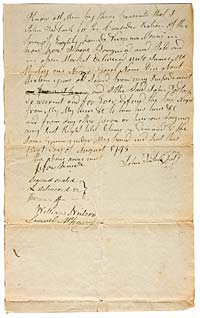Online Extras
Sidebar:
Most Virginians Were LiterateColonial Literacy

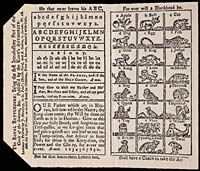
An eighteenth-century English primer for abecedarians memorizing their alphabet and learning their prayers
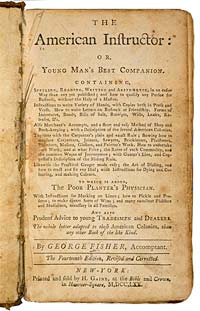
A 1770 primer on the three Rs, penmanship, bookkeeping, carpentry, and nostrums, “adapted to these American colonies”
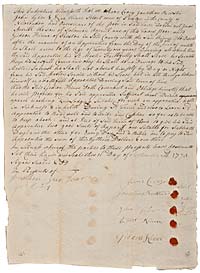
Zoom in on this bill of indenture
A bill of indenture for the apprenticeship of Jacob Averill, witnessed, signed, and sealed by several hands, “overseers of the poor” in the town of Preston, Connecticut. Part of the contract deems Jacob be taught “to read well and to write and cypher.”
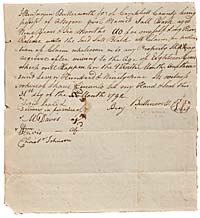
Zoom in on this letter of manumission
Benjamin Butterworth’s letter of manumission for Sall Black, when she reached eighteen.
“Every Man Able to Read”
Literacy in Early America
by Jack Lynch
Freedom of the press was prominent in the minds of the Founders—the First Amendment’s protection of free expression features in every story of the development of the United States. Freedom of the press, though, counts for little without an audience for what is printed, because only a literate population makes the right to a free press meaningful. That’s why Thomas Jefferson said a free press wasn’t enough to guarantee a healthy democracy. As he wrote to Charles Yancey, a prominent Virginia legislator, in 1816, “Where the press is free, and every man able to read, all is safe.”
“Every man able to read.”
Early Americans were uncommonly interested in the power of the printed word, and therefore in literacy. George Fisher’s 1748 educational book, The Instructor; or, American Young Man’s Best Companion, said:
Tis to ye Press & Pen we Morals owe
All we believe & almost all we know.
The press and pen played a large part in shaping the character of eighteenth-century America, but only insofar as there were people to read what was written.
Literacy is among the keys to understanding the early chapters of the American story, but it is difficult to make claims about it—evidence is hard to find. Because the act of reading itself leaves no traces, historians have to look for indirect evidence.
Some of that evidence is clear. A surviving letter or diary in someone’s handwriting, for example, is proof that the writer was literate, and the presence of books in a will is nearly as persuasive. But letters and diaries rarely survive, and about one man in four, and one woman in twenty, left a will. Besides, the wills of people known to be literate don’t necessarily list everything in a household, and books were not always enumerated. Clues like these are valuable when they survive, but they don’t tell us much about the literacy of a larger population.
Other kinds of evidence can tell us more about the populace as a whole. Records from circulating libraries, for instance, are revealing—but again, not many have survived, and in any case they cover only those wealthy enough to pay the subscription fees. The number of newspapers or booksellers in a region likewise provides a rough index of the literacy of the population, though it is impossible to translate these into hard figures about the proportion of people who could read. We can assume that those who attended school learned at least the rudiments of writing, but records are spotty, and some people who never went to school became proficient readers: in the 1960s, historians Bernard Bailyn and Lawrence Cremin reminded their colleagues that education was not synonymous with schooling.
The best evidence of literacy historians find is the ability to sign legal documents. People were often expected to put their name to deeds, parish registers, and baptismal records in early America, but many still signed these documents with a “mark.” In 1766, the English jurist William Blackstone said in his Commentaries on the Laws of England, “Our illiterate vulgar” make “a cross for their mark when unable to write their names.” A signature in a register shows the writer was literate; a mark proves the opposite.
This evidence, though, isn’t entirely reliable. As University of Colorado historian Gloria L. Main says, “Measuring ‘literacy’ is problematical . . . because the term encompasses not one skill but two, each with a separate range of competency”—that is, the ability to read and the ability to write. In the eighteenth century, the two were taught as separate skills. Many people learned the rudiments of reading but never to write—in those cases, a mark in place of a name may give us a false negative about someone’s ability to read. It’s also possible that some people who could not read, or could not read well, learned the alphabet well enough to write their names. In those cases, signing a name gives a false positive.
Despite the caveats, we can generalize about patterns of literacy. In 1974, University of Montana scholar Kenneth Lockridge’s groundbreaking book, Literacy in Colonial New England, surveyed evidence from legal records and offered provisional conclusions—“The exercise is bound to be tentative, as it uses a biased sample and an ambiguous measure”—but he made the case that, among white New England men, about 60 percent of the population was literate between 1650 and 1670, a figure that rose to 85 percent between 1758 and 1762, and to 90 percent between 1787 and 1795. In cities such as Boston, the rate had come close to 100 percent by century’s end.
Lockridge and his successors showed that literacy was higher in New England and the mid-Atlantic colonies than in the South, and higher in the cities than in the countryside. Traders and shopkeepers were more literate than farmers. They showed that American literacy was high by European standards. As the University of Delaware’s F. W. Grubb wrote in 1990:
Of all European countries perhaps only Scotland surpassed America in literacy by 1800. Not only had the European literacy revolution been transplanted to the American periphery during the colonial period, but colonial literacy had somehow leaped past that of northwestern Europe.
Such research confirmed a widespread belief in early America itself. In 1800, a magazine called The Columbian Phenix and Boston Review reported that “no country on the face of the earth can boast of a larger proportion of inhabitants, versed in the rudiments of science, or fewer, who are not able to read and write their names, than the United States of America.”
Perhaps it should have been no surprise, because literacy had been an American obsession since the beginning. As early as 1642, Massachusetts passed a law ordering the selectmen to monitor children’s ability “to read & understand the principles of religion & the capitall lawes of this country.” And though New Englanders were more devoted to public schooling than southerners throughout the eighteenth century, schemes for literacy education were widespread throughout the colonies and the early United States. Thomas Jefferson, for instance, drafted a Virginia Assembly bill in the 1770s, titled “A Bill for the More General Diffusion of Knowledge,” that began:
Those entrusted with power have, in time, and by slow operations, perverted it into tyranny; and it is believed that the most effectual means of preventing this would be, to illuminate, as far as practicable, the minds of the people of large.
He proposed a series of public schools at which “reading, writing, and common arithmetick” would be taught to “all the free children, male and female.”
Jefferson’s qualification, though, demands our attention: “all the free children” excludes slaves, roughly 40 percent of Virginia’s population. This fact had gone largely unnoticed among historians of literacy, who had grown accustomed to writing about the “near-universal literacy” achieved by the end of the eighteenth century. Beginning in the late 1970s, scholars began to ask whether “universal” was the right term. Since so much of the evidence about literacy came from legal documents, it was necessarily limited to those who could sign such documents—which, at the time, usually meant free white adult males. Scholars have begun asking about the excluded groups.
One of the important excluded groups was women. Main has written, “Historians have tended to treat female literacy as a minor postscript to the larger tale of literacy’s spread, but the story for women has important dimensions of its own.” Jefferson’s plan for a public school system included girls, but that was not typical of eighteenth-century education; women’s literacy lagged behind men’s. Lockridge’s figures make the case: while male literacy in New England rose from 60 percent in the late seventeenth century to 90 percent by the early days of the Republic, he estimated female literacy in the same period as rising from 31 percent to 48 percent—roughly half the rate of males.
In some ways, though, the story of women’s literacy is more dramatic than men’s. As Bard College’s Joel Perlmann and Boston College’s Dennis Shirley write, “Half the women born around 1730 were illiterate; virtually all the women born around 1810 were literate.” Though women lagged behind men chronologically, their progress came faster.
The rise in female literacy highlights changes in social roles. As Main writes, “Traditional female roles did not require” literacy,
and powerful prejudices worked to inhibit the public exercise of trained intelligence by women. At some point in the modernizing process, nonetheless, female literacy also began to expand. For this to have occurred, society must first have enlarged its assessment of female capability before liberalizing the scope of permissible feminine activity.
Among the factors for this increase was the rising number of women who became schoolteachers, part of a process Perlmann and Shirley called “the feminization of schoolteaching.”
If it is difficult to develop reliable evidence about free women’s literacy, it is harder still to make claims about slaves, male and female. Here we are often compelled to rely on evidence left by their owners. Though it is fragmentary and frequently unreliable, when it survives, it can be revealing.
George Washington’s will freed all his slaves at his death in 1799. Less familiar is this provision: “The negroes thus bound are (by their masters and mistresses) to be taught to read and write and to be brought up to some useful occupation.” Other slave masters thought it important to educate their enslaved. Many justifications of slavery were based on the premise that introducing “savage” Africans to “civilized” Western society was an act of generosity, giving unenlightened pagans the opportunity of being saved by Christianity. Many owners saw teaching their slaves to read the Bible as a religious obligation.
Historian Jeffrey H. Richards of Old Dominion University tells the story of Samuel Davies, the first Presbyterian minister in Piedmont Virginia, who worked to educate slaves throughout the South in the 1750s. Though not the first, he was the most committed and the most successful evangelical preacher who taught slaves to read, convinced that literacy was a precondition of Christian devotion. Davies, for all his belief in the inherent intelligence of slaves and the need to treat them humanely, was no abolitionist. He made the case to white owners that literate slaves would be “better Servants.” And it is true that some owners saw practical advantages in having literate slaves, since they could form a kind of middle management between the free whites and the illiterate field hands.
But, as Illinois historian Janet Cornelius says, “literacy was a two-edged sword” for owners: slaves’ literacy might serve to increase the owners’ control, “but resourceful slaves seized the opportunity to expand their own powers.” Many slave-owners were nervous about educating their slaves, because
slaves who learned to read and write gained privacy, leisure time, and mobility. A few wrote their own passes and escaped from slavery. Literate slaves also taught others and served as conduits for information within a slave communication network.
Literacy could be the first step on the path to freedom. The slaves knew this better than anyone, and there is a tradition of slave narratives in which the acquisition of literacy is central. Ex-slave and English abolitionist Olaudah Equiano wrote that he “had long wished to be able to read and write,” and “took every opportunity to gain instruction.” In his Interesting Narrative he gives a comic scene of the time he first tried to make sense of the mysteries of writing:
I had often seen my master and Dick employed in reading; and I had a great curiosity to talk to the books as I thought they did. . . . I have often taken up a book, and have talked to it, and then put my ears to it, when alone, in hopes it would answer me; and I have been very much concerned when I found it remained silent.
In the nineteenth century, former Maryland slave, abolitionist, orator, and editor Frederick Douglass described a fascination for “this mystery of reading.” After he got his first few lessons, though, his owner warned the teacher that, “if you learn him now to read, he’ll want to know how to write; and, this accomplished, he’ll be running away with himself.” Douglass’s literacy not only facilitated his own freedom but helped advance the abolitionist cause. For many slaves, learning to read and write was the first opportunity they had to direct the course of their own lives.
The eighteenth century gave us nearly universal literacy, but true universality has remained an aspiration rather than a reality. Since plain-English expert Rudolph Flesch published Why Johnny Can’t Read in 1955, educators have been aware that, even in the wealthiest nation in the world, with one of the most extensive systems of education, literacy remains less than universal. Most disturbing are the disparities in literacy rates among different populations, especially among ethnic and racial minorities. Just as many slaves discovered in the eighteenth and nineteenth centuries, literacy can be a source of power, and never more so than in the twenty-first century.
America remains preoccupied with literacy—such has been the case since colonial times. Every presidential administration in decades has devoted resources to improving literacy, especially that of poorly served segments of the population. It’s not merely a matter of improving job prospects for students with poor reading ability; it’s more fundamental than that. As Thomas Jefferson recognized two centuries ago, a democracy is healthy not only where “the press is free,” but where a literate public is able to make that freedom meaningful.
Jack Lynch, author of Becoming Shakespeare: The Unlikely Afterlife That Turned a Provincial Playwright into the Bard (Walker & Co., 2007) is a professor of English at Rutgers University. He contributed to the spring 2010 journal “His Integrity Inflexible, and His Justice Exact”: George Wythe Teaches America the Law.”
Suggestions for further reading:
- Janet Cornelius, “‘We Slipped and Learned to Read’: Slave Accounts of the Literacy Process, 1830–1865,” Phylon 44, no. 3 (1983): 171–86.
- Robert E. Gallman, “Changes in the Level of Literacy in a New Community of Early America,” Journal of Economic History 48, no. 3 (Sept. 1988): 567–82.
- F. W. Grubb, “Growth of Literacy in Colonial America: Longitudinal Patterns, Economic Models, and the Direction of Future Research,” Social Science History 14, no. 4 (Winter 1990): 451–82.
- Deborah Keller-Cohen, “Rethinking Literacy: Comparing Colonial and Contemporary America,” Anthropology & Education Quarterly 24, no. 4 (Dec. 1993): 288–307.
- Kenneth A. Lockridge, Literacy in Colonial New England (New York, 1974).
- E. Jennifer Monaghan, Learning to Read and Write in Colonial America (Amherst, MA, 2005).
- Joel Perlmann and Dennis Shirley, “When Did New England Women Acquire Literacy?” William and Mary Quarterly, 3rd series, 48, no. 1 (Jan. 1991): 50–67.
- Jeffrey H. Richards, “Samuel Davies and the Transatlantic Campaign for Slave Literacy in Virginia,” Virginia Magazine of History and Biography 111, no. 4 (2003): 333–78.

